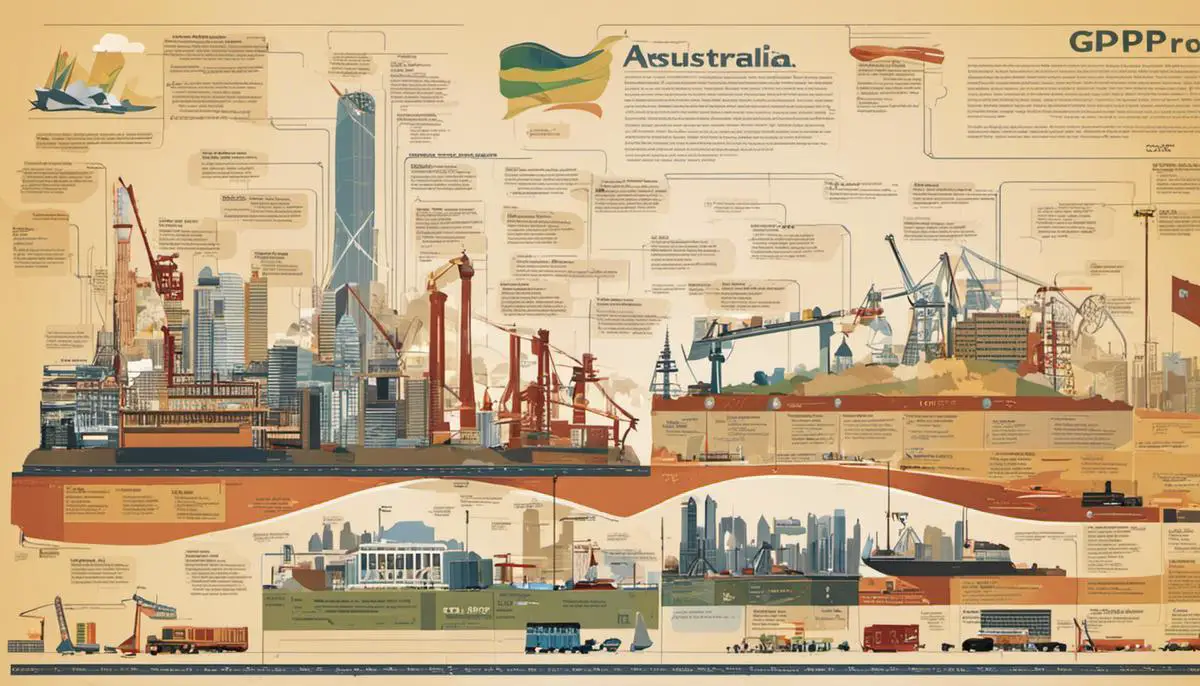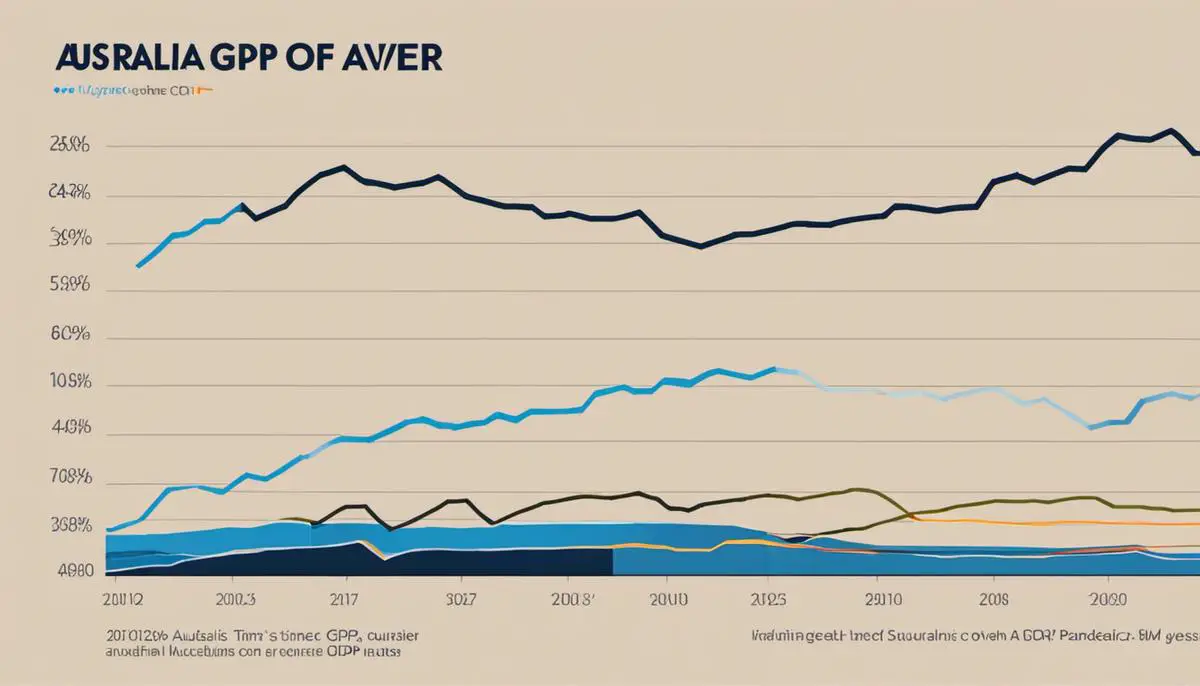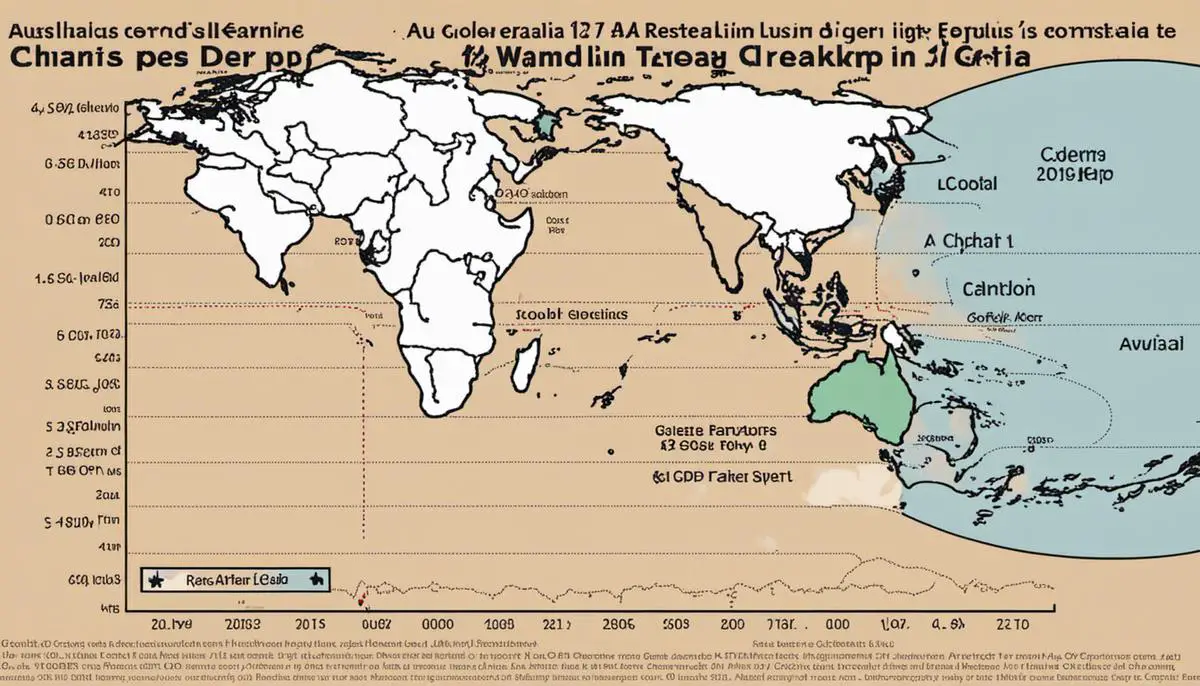The Australian economy, with its diverse sectors such as mining, finance, education, tourism, and agriculture, makes substantial contributions to the global marketplace. The resilience and flexibility of the country’s economic structure stand as testament to the healthy fiscal policies and robustly managed resources that have supported it over past years. Detailed in this text is an exploration into the nation’s economic performance, investigating key performance indicators such as growth rates, GDP, and employment rate, and assessing the historical trends that have helped shape the Australian economy.
Overview of the Australian economy
The Structure of the Australian Economy
At its basic level, the Australian economy is market-based, with a high GDP per capita and a low rate of poverty. The Australian Securities and Investments Commission oversees the Australian economy, which is divided into several key sectors. Each of these sectors contributes in varying degrees to the country’s overall Gross Domestic Product (GDP).
Mining Sector
The Australian mining sector is a significant driving force behind the economy. Australia is rich in natural resources such as coal, iron ore, copper, gold, natural gas, and uranium. These minerals contribute greatly to the nation’s export portfolio. In fact, the mining sector accounted for about 10% of Australia’s total GDP, signifying its critical role in the economy.
Finance Sector
The finance industry also plays a crucial role in driving Australia’s economy. Including banking, insurance, and financial services, it contributes to about 9% of the country’s GDP. The finance sector not only facilitates economic growth by channeling funds from savers to business investments, but it also creates numerous employment opportunities.
Education Sector
Education services form a major part of Australia’s service sector, contributing to about 5% of the country’s GDP. Higher education, particularly, is a significant export for Australia, as it attracts many international students. This sector’s role in GDP highlights the importance of tertiary education as an economic driver.
Tourism Sector
Tourism is another significant factor in the Australian economy. Encouraging both domestic and international tourism, it contributes to about 3% of the nation’s total GDP and support jobs. Australia’s unique fauna, flora, cultural heritage and iconic landmarks like the Sydney Opera House, the Great Barrier Reef and Uluru attract millions of global tourists each year.
Agriculture Sector
Lastly, the agriculture sector contributes around 2% to Australia’s GDP. Although the agriculture sector’s contribution to GDP is smaller compared to other sectors, it remains crucial due to its role in providing essential items such as food and fiber. Australia’s agricultural products like wheat, beef, and wool are also significant contributors to the country’s exports.
Insights into Australia’s Economic Position Globally
As of 2021, Australia claims the 13th spot in the global economy when evaluating it through the lens of Gross Domestic Product (GDP). This ranking, issued by the International Monetary Fund, highlights Australia’s economic strength and resilience. Located within the Asia-Pacific, the fastest-growing region globally, Australia’s strategic geographical placement significantly contributes to its robust economy. The World Bank also lauds Australia for its business-friendly environment, a factor that brings even more vigor and stability to its already strong economic structure.

Australia’s economic performance in past years
A Closer Look at Australia’s Economic Progress
As a high-income nation with a powerful economic framework, Australia remains one of the world’s leading economies, as it holds the 14th spot in terms of nominal GDP. It showcased an impressive streak of uninterrupted growth from 1991 to 2019, with an average growth rate of 3.3% annually. This consistent upward trajectory is attributed to Australia’s thriving resources trade, particularly with Asian nations, a solid domestic market, and intelligent government fiscal policies.
Gross Domestic Product (GDP) Trends
The Gross Domestic Product (GDP) of Australia has shown a steady increase over the past 25 years, with only a few minor downturns. In 2000, Australia’s GDP stood at AUD $634.52 billion and grew consistently till it reached AUD $1.89 trillion in 2019. However, due to the global COVID-19 pandemic, Australia’s economy contracted by 0.3% in the first quarter of 2020 and by 7% in the second quarter – the largest fall on record, pushing the country into a technical recession.
Employment and Unemployment Trends
Employment rates in Australia maintained steady growth until the first half of 2020, reflecting the influence of strong economic performance. The Australian Bureau of Statistics reports that the employment rate for adults aged 15 and over has risen gradually over the last 20 years, reaching 74.7% in March 2020. However, like many nations around the globe, Australia experienced rising unemployment rates with the onset of the COVID-19 pandemic, with rates peaking at 7.5% in July 2020.
Inflation and Fiscal Policy
Over the past few decades, Australia has experienced a relatively low and stable inflation environment, with the Reserve Bank of Australia (RBA), the country’s central bank, maintaining a target of 2–3% for annual consumer price inflation. In terms of fiscal policy, Australia has sought to maintain budget discipline, proving effective during the global financial crisis of 2007–2008 when the government successfully deployed a large fiscal stimulus to shore up the economy.
Comparative Analysis
Australia’s economy performed exceptionally well compared to other advanced economies in the wake of the global financial crisis. Its resilience has been attributed to sound macroeconomic and structural policies, and a strong regulatory framework. Moreover, high commodity prices and strong ties with emerging economies, especially China, have also played vital roles in bolstering Australia’s economy.
Main Factors Influencing the Australian Economy
Various pivotal events have played significant roles in molding the Australian economy in recent years. These include the mining boom, the global financial crisis, alongside the evolving dynamics of worldwide trade. However, the COVID-19 pandemic has had the most direct and substantial impact. This global health crisis has wreaked havoc on international supply chains and created an environment of pervasive economic instability, thereby underscoring the delicate balance that Australia needs to strike between its economic ambitions and public health objectives.

Australia’s current ranking in global economy
Present Global Standings
Drawn from data provided by the World Bank that takes into account the Gross Domestic Product (GDP) – the cumulative value of all goods and services produced within the boundaries of a nation, Australia currently holds the rank of being the 14th most significant economy globally.
GDP and GDP per Capita
As of 2020, the GDP of Australia was roughly 1.33 trillion U.S. dollars. This is a considerable increase from a decade ago, reflecting the strength and growth of the Australian economy. The GDP per capita, a measure of the average income per person, was $55,060 in 2020, placing Australia in the world’s top 20.Economic Competitiveness
In the World Economic Forum’s Global Competitiveness Report, Australia’s economy was ranked 18th out of 141 economies. This competitiveness is measured based on several factors including the state of a country’s infrastructure, macroeconomic environment, health and education levels, and market efficiency.Ease of Doing Business
The World Bank also measures the ease of doing business in different countries. As per its recent report, Australia is ranked 14th in the world in this regard, showing an accommodating environment for business and entrepreneurship. This ranking is based on several aspects including starting a business, dealing with construction permits, getting electricity, registering property, getting credit, protecting minority investors, paying taxes, trading across borders, enforcing contracts, and resolving insolvency.Unemployment Rates
Australia has also managed to maintain relatively low unemployment rates, even during global crises. The Australian Bureau of Statistics reported an unemployment rate of about 6.6 percent in 2020, a surge caused by the pandemic, but it decreased to 5.6 percent in 2021. Such a rate demonstrates Australia’s resilience and ability to adapt to crises.Trade Structure
A significant part of the Australian economy is its external sector, with the country being a leading exporter of natural resources, energy, and food. Australia is the world’s largest coal (fourth-largest reserves), iron ore, and lead exporter. It also has substantial exports in liquefied natural gas and gold.The Big Picture
The Australian economy is not only resilient but also diversified, demonstrating strength in many areas on an international scale. Australia’s commitment to maintaining an open trade policy, deregulating its markets, and cultivating a favorable environment for businesses positions it as a significant contender in the worldwide economic field.
Comparison of Australia’s economy with other developed countries
Diving Deeper: Australia’s Economy Position in the Global Stage
When it comes to the world economic ranking, Australia consistently holds a leading position. The International Monetary Fund (IMF) recorded in 2020 that Australia had the 14th largest economy worldwide, based on nominal GDP. With its annual GDP circling around AUD$1.5 trillion, Australia stands ahead of other prosperous nations like Spain, South Korea, and Mexico.
Australia and the United States
In comparison to the United States, the world’s largest economy, Australia’s economy is significantly smaller. U.S. GDP exceeded $21 trillion for 2020, far larger than Australia’s economy. However, when considering GDP per capita, the gap is much smaller. Australia’s GDP per capita, as of 2020, is around $55,060, ranking 10th globally compared to the U.S at $63,543, according to World Bank data.
Comparison with Canada
Australia’s economy is more substantial than Canada, which is ranked 9th, with a GDP of around CAD$1.64 trillion. However, considering GDP growth rates, Canada typically surpasses Australia. The Canadian economy is known for its strength in natural resource extraction, similar to Australia, which often leads to a synchrony in economic performance.
Comparison with Germany and the UK
Comparing Australia to economies of Europe, Germany’s economy exceeds Australia, ranking as the world’s fourth-largest economy by nominal GDP. However, Australia’s GDP per capita surpasses that of Germany, ranking at around $55,060 compared to Germany’s $45,466.
The UK, another significant European economy, also has a larger nominal GDP than Australia, positioning it at the sixth place. Yet, in GDP per capita terms, Australia again takes the lead over the UK.
Economic Growth Rate
In terms of economic growth rate, Australia maintained stable growth prior to the COVID-19 pandemic, generally around 2-3%. The pandemic saw a drop, but steady recovery is expected, with projections for 2021 above 4%. This recovery rate is faster compared to many of the developed European economies like the UK and Germany.
Employment and Debt to GDP Ratio
Australia’s employment rate remains high, with an estimated employment rate of over 70% in 2020. When it comes to debt to GDP ratio, as of 2020, Australia’s debt equates to approximately 45% of its GDP, which is relatively low compared to countries such as the U.S. and Japan.
Technological Innovation
Regarding technological innovation, Australia stands at the 22nd position on the Global Innovation Index 2021, lower than the U.S, UK, and Germany, but higher than Canada. Sectors such as information technology, biotechnology, and advanced manufacturing are making major strides in the Australian market.
Wrapping Up
When observing the economic size and GDP per capita, Australia consistently ranks among the top nations across the globe, which is impressive given its somewhat smaller population size.

Projected future trends for Australia’s economy
Forecasting Australia’s Economic Growth
Australia’s economy has displayed a strong resistance to a variety of global financial crises over the years. Looking towards the future, growth forecasts are heavily dependent on how the ongoing pandemic situation unfolds and the success of post-pandemic recovery efforts. As per the June 2021 predictions by the Organisation for Economic Co-operation and Development (OECD), Australia’s economy is set to expand at 5.1% in 2022. On a similar note, the International Monetary Fund (IMF) also predicts a steady growth rate of 2.5% in the years following 2022. However, it’s crucial to note that these growth predictions will hinge largely on the world’s ability in restricting the spread and mitigating the repercussions of Covid-19.
Sectors to Watch
A variety of sectors are expected to contribute significantly to Australia’s future economy. The technology sector, including ICT, digital services, and fintech, is seen as a key growth driver. Australia’s abundant natural resources also make the green energy sector significant, with solar and wind power harnessing standing out.
Moreover, the mining sector will likely continue to be fundamental to the Australian economy with commodities like iron ore, coal, gold, and increasingly, lithium – required for battery technology – being key exports. Shifts towards a focus on a scarcity of globally traded critical minerals provide opportunities for the mining sector.
Potential for Employment Growth
Australia’s unemployment rate has shown a steady decline after the initial effects of the Covid-19 pandemic. The Australian government anticipates a trend towards full employment (considered to be an unemployment rate of 4.5%) by 2023. Continued growth in the tech sector will likely lead to more jobs in that industry, while a shift towards green energy could also open up more positions. Healthcare is another domain where significant job growth is anticipated due to an ageing population.
Impact of Global Events: Climate Change and Geopolitical Trends
The future trajectory of Australia’s economy ranking is intrinsically linked with global events, particularly climate change and geopolitical shifts. The consequences of climate change may pose challenges to traditional sectors like agriculture and mining, but simultaneously generate opportunities in sectors such as sustainable energy and environmental services.
Geopolitical tensions, especially with China – Australia’s largest trading partner – could influence the health and direction of Australia’s economy. The future trends of trade, global politics, and international relations will undoubtedly influence the sectors that drive economic growth, shape employment rates, and affect Australia’s economy ranking.
In conclusion, Australia’s future economy is poised to be influenced by various factors, including its sector growth, employment trends, and the fallout from global events. Successful navigation through these will largely determine its economic ranking among other nations.

Australia has maintained an impressive economic performance and strives to continue this upward trajectory. This is fueled by the powerful synergies of its diverse economy, with an undeniable potential to further bolster the global standing through its various sectors. Going forward, by considering expert predictions and analysis of potential future trends, one may anticipate the emerging opportunities and challenges that these sectors may encounter. These influences, alongside the far-reaching implications of global events such as climate change and geopolitical trends, will continue to shape Australia’s economic future.






